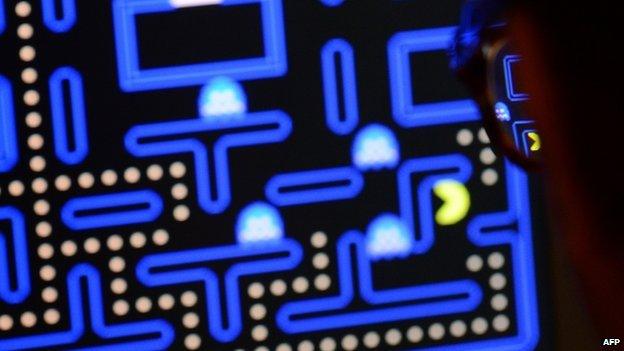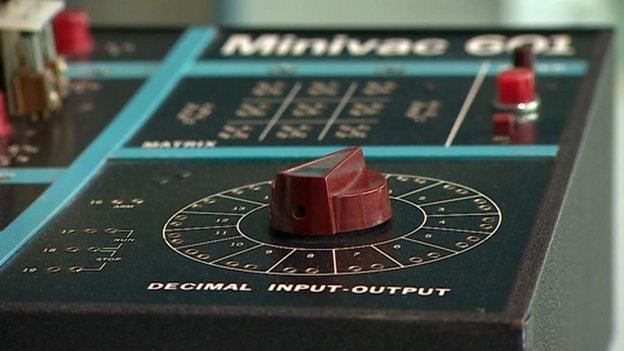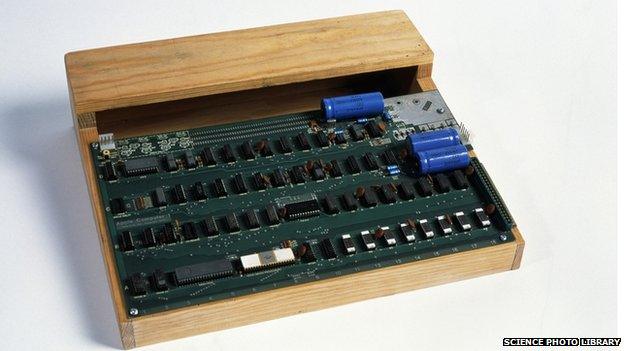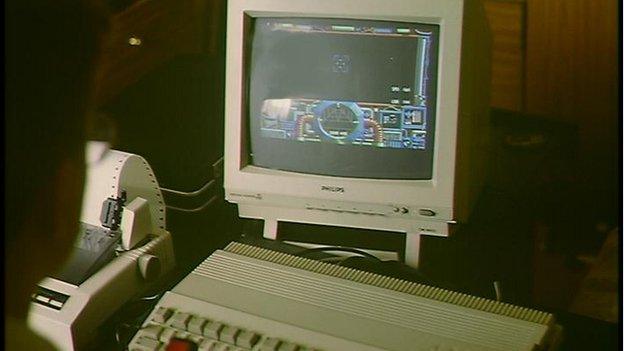Your Money: Are old computers a potential investment?
- Published

Bring back your childhood and play with the Pac-Man video game once more
"Wow! Look at this place!"
The first words of everyone who comes through the door at the Centre for Computing History in Cambridge are always the same.
In a cold warehouse the size of a large school hall, hidden away on an industrial estate, row upon row of computers are laid out.
They buzz away, chirping as their screens display the time-thieves of children from the 1980s and 1990s: Pac-Man, Manic Miner, Space Invaders, Jet Set Willy, Legend of Zelda...
There are hundreds of familiar names here, all glimmering in their brightly coloured glory and, crucially, and visitors are encouraged to sit down and have a play.
It is not just the games that people coo over, either.
Just nostalgia?

The Minivac 601 at the Centre for Computing History museum in Cambridge
The room is a monument (or perhaps a graveyard) to household names - brands that still have the power to evoke strong loyalties in anyone over the age of 35 but that have since slipped into obscurity.
Sinclair ZX81s and Spectrum 48K machines sit happily alongside rivals with which they fought to the death: Commodore 64s, BBC Micros, Amigas and Atari STs.
"Oh! I'd forgotten about that!"
Another visitor has spotted a Big Trak - a white, plastic, programmable electric sci-fi tank that children told how to move by pressing in a sequence of buttons, standing back and watching it crawl away across the floor.
Retro computing is helping to drive interest in collecting, as Philip Hampsheir reports
But this museum is more than simply nostalgia.
It is an example of the surging interest in the origins and history of computers.
And where there is passion and limited supply, there is a market for collectables.
Sharp rise in value

The Apple 1 computer, first made in 1976, one of which recently sold for $671,000
"We have an Altair here," Jason Fitzpatrick, the museum's founder says.
"It's the machine that really did kick off the home computing revolution. Of those machines, we have serial number 3. I have no idea how much it's worth now but I can tell you I paid £11,000."
That was many years ago.
Since then, old computers have risen sharply in value.
In May 2013 in Germany, an original Apple I computer, one of just 200 soldered by Steve Jobs and Steve Wozniak in their garage, came up for auction.
It sold for $671,000.
The backbone of the Centre for Computing History's display grew out of Mr Fitzpatrick's own personal collection.
It simply got too big and needed to be rehoused.
Even though competition among the different collectors can be fierce, there's a collaborative air to their community, Mr Fitzpatrick explains.
After all, everyone wants to see these machines preserved - and when computers come to the end of their useful life, most people just throw them out.
"There are those people that had them as a kid and are building that collection from there," Mr Fitzpatrick says, "but there's also a new generation of people out there who are investing in these things as something that will maybe rise in value in the future."
He thinks the increase in people collecting computers as an investment is helpful.
"It's a way of legitimising your collection. You know your machine is valuable, it's probably not going to be worth any less, so it's an 'investment'."
Bletchley Park

How we used to play with the Commodore Amiga home computer, back in 1989
Like many collectors, Mr Fitzpatrick has no serious intention of ever cashing in on the value of the stash he has built up.
Fifty miles away at Bletchley Park, home of Britain's famous World War Two code breakers, is the National Museum of Computing.
Robert Dowell is an educational guide who works freelance, enthusing to tours about the history and importance of the machines.
Like Mr Fitzpatrick, he amassed a large collection and then donated it to the museum.
He walks around the displays, providing an in-depth history of some of the more esoteric items.
"The Apple Lisa came out in 1983," Mr Dowell says. "It provided the first graphic user interface."
It sold poorly, for the time, with just 100,000 models bought.
"It can command a price from £3,000 to £20,000 depending on its age."
For him, there are four key aspects to collecting computers, each of which affects a machine's value: nostalgia, fashion, rarity and provenance.
Most collectors get into the scene because they want to buy something from their childhood - that is nostalgia.
Fashion refers to the big breakthroughs for the industry - models such as the first tablet computer or the first colour display.
Search in bins
Rarity is for when an item had a limited production run - such as Acorn's Phoebe, a canary yellow machine designed to compete with IBM compatible machines that was cancelled in 1998.
Only two prototypes were made and one is housed at the museum in Bletchley Park.
Provenance provides context in history.
Mr Dowell tells the story of a collector who had an Apple I and it broke so he sent it back to be repaired. He was offered a free upgrade to the Apple II but turned it down.
He received a repair note signed by Steve Jobs.
That increases the machine's value today considerably.
The entry level for collecting computers is very low and that can be a huge advantage.
Because most people regard them as valueless, older models can be picked up for free.
"Libraries and schools sometimes wheel these out and leave them beside bins in the street," Mr Dowell says, pointing to one model with a wry smile.
- Published3 February 2015

- Published26 November 2014

- Published30 July 2013
